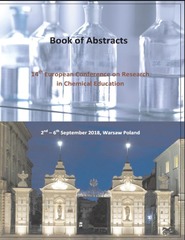Приказ основних података о документу
Convergent - Divergent Thinking of Primary and Secondary School Students Associated with Open-Ended Chemistry Problems
| dc.creator | Trivić, Dragica | |
| dc.creator | Milanović, Vesna D. | |
| dc.date.accessioned | 2022-05-16T09:27:46Z | |
| dc.date.available | 2022-05-16T09:27:46Z | |
| dc.date.issued | 2018 | |
| dc.identifier.uri | http://cherry.chem.bg.ac.rs/handle/123456789/5107 | |
| dc.description.abstract | A lot of chemistry teachers express their concern regarding the thinking levels their students use. They wonder how to improve the higher level thinking skills of their students. Teachers are usually satisfied with the students’ convergent thinking during the problem solving, i.e. when they apply the main chemistry ideas logically and produce one correct answer. The key problem of this research is the divergent thinking of primary and secondary school students when they solve open-ended designed chemistry problems, with the contribution of logical, critical and evaluative thinking. Divergent thinking is defined using indicators such as: (i) fluency – the ability to think of many ideas or many possible solutions to a problem, and (ii) flexibility – the ability to use ideas in a new, different, and unusual way 1. The first examination was conducted with primary school students aged 14 in the school year 2016/2017. The obtained results have shown that 30% of students were able to formulate more acceptable responses to the given open-ended chemistry problems, i.e. the fluency and flexibility of students’ answers were indicated. This finding is important because the students from this sample had not had this kind of experience and demands in their previous education. In addition, the primary school students showed that they could combine the previously acquired knowledge of chemistry, connect it with everyday life, and thus find original answers. The second examination was conducted with secondary school students aged 16 in the school year 2017/2018. It was shown that about 30% of the secondary school students were able to produce different responses in the items which did not require chemical calculations. As far as stoichiometric calculations are concerned, the percentage of students who were able to formulate more acceptable responses to the given open-ended chemistry problems was less than 10%. The results of these studies can be used to further develop the approaches which support the divergent thinking of primary and secondary school students in teaching chemistry, as well as to monitor and evaluate the effects of such work by evaluating students' achievements in open-ended problems. References: [1] J. P. Guilford, Characteristics of Creativity (1973) (PDF Download Available). Retrieved February 5, 2017 from the World Wide Web http://files.eric.ed.gov/fulltext/ED080171.pdf | sr |
| dc.language.iso | en | sr |
| dc.relation | info:eu-repo/grantAgreement/MESTD/Basic Research (BR or ON)/179048/RS// | sr |
| dc.rights | openAccess | sr |
| dc.rights.uri | https://creativecommons.org/licenses/by/4.0/ | |
| dc.source | 14th European Conference on Research in Chemical Education, Book of Abstracts WARSAW, POLAND 2 nd – 6 th September, 2018 | sr |
| dc.title | Convergent - Divergent Thinking of Primary and Secondary School Students Associated with Open-Ended Chemistry Problems | sr |
| dc.type | conferenceObject | sr |
| dc.rights.license | BY | sr |
| dc.citation.spage | 81 | |
| dc.citation.epage | 81 | |
| dc.type.version | publishedVersion | sr |
| dc.identifier.fulltext | http://cherry.chem.bg.ac.rs/bitstream/id/29829/Book_of_Abstracts_14_ECRICE_2018-mm.pdf | |
| dc.identifier.rcub | https://hdl.handle.net/21.15107/rcub_cherry_5107 |


